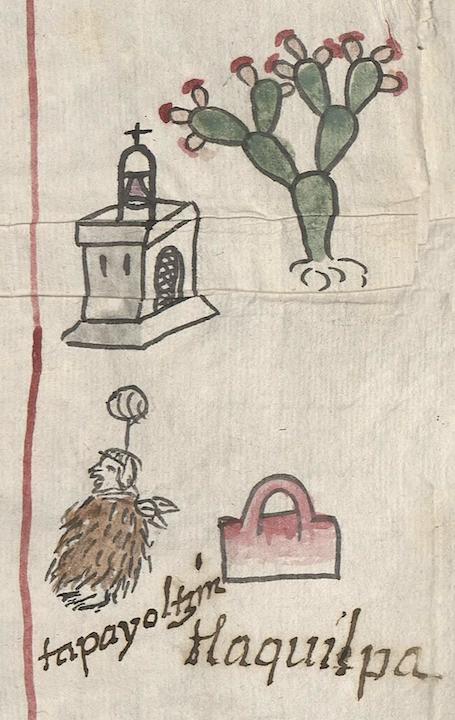Tlaquilpan (CmpRG)
This is a simplex glyph for the toponym Tlaquilpan. It appears on the map included with the 1580 Relación Geográfica de Cempoala (originally, Cempohuallan), in the contemporary state of Hidalgo. The black-outlined rectangle represents the Nahuatl noun for stucco (tlaquilli) (or perhaps the verb, to stucco) or tlaquilqui (the tool for applying stucco). The locative -pan, “on, at, with,” etc., is not visualized. The glyph appearing on the Relación has what looks like a handle attached to the top depicting a tool used for applying stucco or plaster. It is a glyph found in the Codex Mendoza, as well (see below), though the present example lacks the line in the Mendoza rendition that separates the tool’s handle from the blade below it. Also unlike the Mendoza glyph, this one is shaded in red fading to pink.
Robert Haskett
Molina also gives tlaquilqui as the person who applies the stucco and tlaquilli as something stuccoed or polished, burnished, or shining. Olmos (1547, f. 200v) translates tlaquilli as "encalar" (to stucco, a verb). So, while the word can be a verb or describe a thing that has received the action of stuccoing or polishing, it also seems to represent the noun for stucco. In the Florentine Codex, Book 10, folio 18r, a tool much like this may be employed in the making of mortar, another (similar) job for a mason.. In the Florentine Codex, Book 10, folio 18r, a tool much like this may be employed in the making of mortar, another job for a mason. The red color added to this tlaquilqui tool may relate to the fact that many autonoumous-era buildings across Mesoamerica were covered in red stucco. (See: Lorenzo Lazzarini, Interdisciplinary Studies on Ancient Stone, 2002, 516, note 12.) Tlaquilpan was one of the four cabeceras (head towns) of Zempoala. On the map, the simplex glyph appears above an alphabetic gloss (see below) and below and to the right of a black and white drawing of a church (except for the tan-shaded bell in the tower) serving as a semantic indicator that Tlaquilpan is an inhabited place. To the left of the simplex glyph is a human figure facing in profile to the left. He is dressed in skins and has a glyph linked to his head by a black line, and with the name Tapayoltzin glossed at an angle beneath him (see the historical contextualizing image). There is also a large rendition of a nopal cactus with roots showing, and with red flowers bursting from its fruit, to the right of the church. This may also be a semantic indicator for the flora of this arid area that is incorporated in what is now the southeastern part of Hidalgo state. For more information about the Relación, see Mundy, Barbara E., “Mapping Babel: A Sixteenth-Century Indigenous Map from Mexico,” The Appendix, 1:4 (October 2013), Mundy (1996), 132, and Ballesteros García (2005), 61.
Robert Haskett
tlaquilpa
Tlaquilpan
Robert Haskett
1580
Robert Haskett
place name, toponym, stucco, estuco, albañil, albañiles, masons, herramientas, nombres de lugares

tlaquilqui, a tool for stuccoing, or the person who applies the stucco, https://nahuatl.wired-humanities.org/content/tlaquilqui
tlaquil(li), stucco or something stuccoed, https://nahuatl.wired-humanities.org/content/tlaquilli
-pan, a locative meaning on, at or in-place; over, on top of; with, by means of; for, in favor of; about, https://nahuatl.wired-humanities.org/content/pan
estuco
Robert Haskett
Relación de Cempoala - University of Texas Libraries Collections. 1580-11-01. https://collections.lib.utexas.edu/catalog/utblac:f87917e2-e3c9-4eb2-a83...
Materials that are in the public domain (such as most of the maps in the PCL Map Collection) are not copyrighted, and no permission is needed to copy them. You may download them and use them as you wish. The image appears here courtesy of the University of Texas Libraries, The University of Texas at Austin. If you do publish anything from this database, please cite the Visual Lexicon of Aztec Hieroglyphs.




